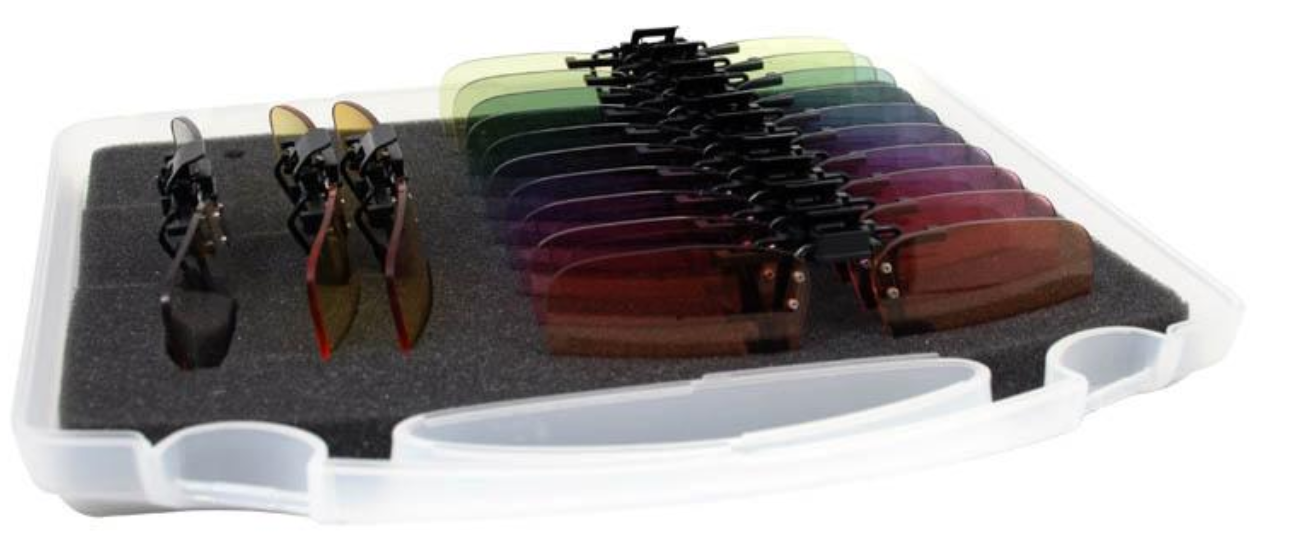History and what's new

Some individuals with apparently normal eyesight, experience discomfort when viewing a page of print. Some report that the words appear to move, wobble or flicker while others say that the page appears too bright or the words are too close together.
This condition is variously referred to as Irlen syndrome, Meares-Irlen syndrome or Visual Stress. Those affected may skip words or lines when reading. Others report eye strain or headaches after reading.
There is now considerable evidence that, for reasons that are poorly understood, these symptoms are sometimes relieved by changing the background colour to the print. This can be achieved by placing a coloured filter over printed text (coloured overlay) or by wearing spectacles with tinted lenses. Computer users can be helped in the same way by changing the screen colours. The colour required to achieve optimum relief varies between individuals and may change over time.
Professor Arnold Wilkins from Essex University working with teachers, psychologists and optometrists, was among the first to investigate this phenomenon scientifically and has developed a range of tests and tools for investigating and treating individuals with the condition.
As scientific and anecdotal evidence for the beneficial effects of colour has mounted, an increasing number of teachers, psychologists, optometrists, orthoptists and others have started screening for Visual Stress syndrome. The conventional method for screening involves manually presenting a range of coloured overlays/filters and asking the observer to report which colour is optimum in terms of reducing any symptoms. This process is somewhat tedious and prone to a variety of client and examiner biases.
City Coloured Overlay Screener
In a bid to improve the efficiency of the process, a team of scientists led by Professor David Thomson, started developing a Windows-based screening program in 1998. After careful evaluation, the City Coloured Overlay Screener was launched in 2001. The program simulated the coloured overlay testing protocol and provided a reliable indication of the optimum Intuitive Overlay for individuals with Meares Irlen syndrome. The program proved to be very popular and soon hundreds of teachers and eye care professionals were using it.
ReadEZ
The success of the City Coloured Overlay Screener led to a growing number of requests to expand the system to allow the determination of the optimum colour for coloured lenses and computer screens. Users reported that existing systems for prescribing coloured lenses were outdated and very expensive and overlays were or variable quality.
At this stage, Thomson Software Solutions made the decision to provide a complete spectrum of solutions for the diagnosis and management of Visual Stress syndrome under the brand name of ReadEZ. The ReadEZ portfolio includes:
- Screening software
- Coloured Overlays
- Coloured Reading Guides
- Coloured overlay swatch
- Coloured clip-ons
- Plano uncut coloured lenses
- Prescription coloured lenses
- Virtual Overlay software for tinting computer screens
- Point of sale materials
- Web pack
The ReadEZ system provides a simple, efficient and cost-effective way of determining the optimum colour of overlays, coloured lenses and computer screens.
Overlays are available in the 12 ReadEZ colours while lenses come in 24 colours and saturations. Lenses are available as coloured clip-ons for those who already wear spectacles, or as non-prescription and prescription lenses. The system has been developed by Professor Thomson in collaboration with Norville Optical, a leading supplier of ophthalmic lenses.

The ReadEZ system proved to be an instant success with clinicians reporting that it was easy to use, cost effective and accurate. The number of practices using the system increased rapidly. By 2016 more than 350 optometric practices were using the system.
What's new
While feedback regarding the ReadEZ system was generally very positive, there were requests for a number of improvements:
- A number of changes to the screening software including:
- Fully featured SQL database
- Ability to record multiple baselines (results with a white background)
- Time-line to show changes in reading performance over time
- Facility for having a control screen and test screen on dual monitors
- Ability to take audio/video recordings during Rate of Reading test
- Ability to record transcript of errors during Rate of Reading test
- Improvements to the flow of the screening test
- Additional text options during screening
- A second (darker) level of saturation for the ReadEZ lenses
in 2020, a new version of ReadEZ was launched which addresses all of these issues to provide a state-of-the-art solution for managing Visual Stress.